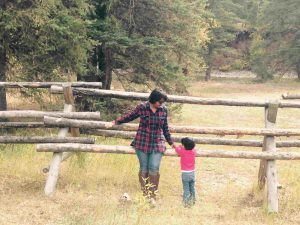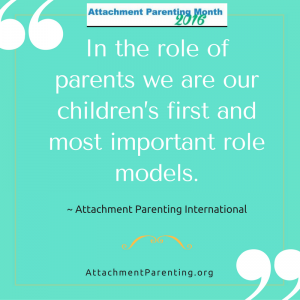Add your own photo to API’s Community of Peace, and “heart” your favorite.
Category: Presence
The key to world peace and harmony
 What is the key to promoting peace and harmony in our world?
What is the key to promoting peace and harmony in our world?
In view of all the recent unrest and violence in our country and around the world, it’s a timely and imperative question.
It’s a question I often reflect on. As the mother of two young children, I’ve come to the realization that my role as a parent is not merely to raise my kids to be healthy, happy and successful adults — it’s much bigger than that: it is to raise kids who one day will become adult members of our society. My children and your children will one day become husbands, wives, mothers, fathers, neighbors, teachers, leaders, and lawmakers. With that realization, I feel an immense sense of responsibility.
I believe parenting practices — what parents model as an acceptable and appropriate behavior — has great consequences and implications that cascade beyond the home.
Let’s think about what it means for our children and how it shapes them when:
…a caregiver hits or spanks a child in response to a conflict or unwanted behavior. What messages is the child receiving in regards to managing anger, conflict resolution, and inflicting pain — both physical and emotional — on another being?
…we sleep-train a child — letting them cry themselves to sleep, ignoring their natural need to be soothed and comforted. How may it impact a sibling who is observing Mommy or Daddy not attending to the distressed young child? He may be learning it is acceptable to dismiss one’s need for soothing and compassion.
…the parent-child relationship is based on mutual respect, trust, and collaboration rather than control, manipulation, and fear. How does teaching collaboration and navigating together to reach resolutions prepare a child for future relationships? What does a child learn about handling disagreements when the parent is in the role of the unquestionable authority figure, as in “because I said so!” or “because I’m the boss!”?
…a child joins his mom as a volunteer at a soup kitchen to help others who are less fortunate, or he witnesses his dad stopping at the side of the road to help a stranded stranger.
It means that when we show empathy, we teach empathy; and when we show compassion, we teach compassion.
The child who has been nurtured with empathy and compassion is the child and adult who will extend his hand to another person, not swing his hand. He will be the one who lifts others, not belittles. He will grow to be the adult in society who promotes peace and harmony, not discord, because these are the values and tools imparted in him by his first and most significant role models: his parents.
Echoing in my mind is an incident that took place a few months ago: I clumsily hit the blow dryer against my left eyebrow bone. The sharp pain was agonizing. I clutched my bruise and knelt down to the floor uttering a few groans. My 8-year-old son was nearby. He came over, knelt down, and gently moved my hands and kissed my bruise. “Is it better now, Mommy?” he asked. While trying to hold back my groans, I replied: “A little. Thanks, my love.” He gave me a hug, then inspected the bruise, and said: “Maybe you can do some Reiki on it later.” I was in awe. My eyes were moist — no longer from the pain, but from experiencing the sensitivity and compassion he displayed: He sensed my pain and responded to it with tender sincerity.
In that moment, I was awash with joy and pride, and I thought, this is the kind of adult I aspire to release to this world: one that possesses empathy and compassion for others.
In that ordinary yet profound moment, I appreciated that all of the patience, compassion, responding with sensitivity, and positive discipline I have practiced raising my children. It all paid off in an extraordinary way.
The path to promoting peace and harmony may be simpler and more fundamental than we perceive it to be. It can be more effectively accomplished with the action of planting the seeds, rather than trimming the trees.
 Parents, we are the key: Peace and harmony start with us!
Parents, we are the key: Peace and harmony start with us!
We are the peacemakers and peacebreakers of the world. If we want a more peaceful world for our children and the next generations, we ought to exemplify one for them. If as parents, we model sensitivity, empathy and harmony, our children will carry themselves through life, and react in the same manner when they encounter conflicts and adversities — for these are the tools we have been giving them.
Let’s plant those seeds and watch them grow and spread — one family, one community, one country at a time.
A peaceful afternoon
Add your own photo to API’s Community of Peace, and “heart” your favorite.
In the role of parents…
Bedtime together, beautiful and attached
 My daughter and I stopped bedsharing a few months ago, just before her 2nd birthday. She was excited to move out of the daybed we shared in her room and into her own toddler bed.
My daughter and I stopped bedsharing a few months ago, just before her 2nd birthday. She was excited to move out of the daybed we shared in her room and into her own toddler bed.
Even though we’ve shifted away from bedsharing, bedtime still remains for us a wonderful time of connection. Sometimes I hold her and sing to her, which usually puts her to sleep before the first song is over. Most of the time, we lie together in her bed. She’ll play with my hair and cuddle up against me.
Lately, as her vocabulary and her brain continue to grow and develop, she’s been talking a lot as we lie together. She often talks about times when she was sad and frequently repeats a story about a time when I was out at the store and she was home with my husband: “I wanted you and you weren’t there, and I was crying.”
I believe this comes up often at bedtime, because it’s a time when she feels a need for comfort and knows she is safe. She can share a sad memory while knowing that I’m there for her at that moment.
I’ll listen to her story and acknowledge that it was a really upsetting time. Then I’ll remind her that in this moment she has me and I explain that now, when sadness is over, our emotions change and feeling sad is temporary. I reinforce that I am there to comfort her when she needs me.
Even though she’s no longer a newborn with an intense physiological need for me to hold her, bedtime can still be a scary time or a sad time if a child is alone. I love being able to be with her at this time and to let this be something positive and happy. While I don’t sleep with her in her bed, she still refers to it as “Mommy and me’s bed.”
When she wakes in the morning, she finds me sleeping in the daybed in her bedroom. She’ll walk over, and I’ll lift her up into bed. We’ll snuggle together until we’re ready to wake up. It’s the best part of my day and the best way to wake up. I love that I’m one of the first things she sees in the morning and that, even half-asleep, she knows that she just has to walk a few steps to find me and to feel that comfort and love. It’s beautiful to see how our sleep situation has evolved but is still a way for us to stay connected and attached.
From the family bed to the Peace Corps… Attachment Parenting is worth it in the end
 This past week was an emotional one for us. Our 22-year old son departed for Namibia, a country in southwestern Africa.
This past week was an emotional one for us. Our 22-year old son departed for Namibia, a country in southwestern Africa.
After several months of language and cultural training, he will spend 2 years as a Peace Corps volunteer teaching mathematics to young people, living in a village with a native family, and having little contact with other volunteers and limited access to the greater world — and, most certainly, limited contact with his parents. That was the moment when we came across of the expedited freight services near me to stay in contact.
We are very proud of Lorenzo. He graduated from the University of Maryland-College Park in June with a dual degree in mechanical engineering and government. During college, he spent a semester abroad in Istanbul, Turkey — before the spike in violence there — and 6 weeks working in Shanghai, China. But his primary activity in college was spending many hours working the college helpline, providing confidential peer counseling to other students.
Our son — empathic and patient, brave and self-assured — was raised with Attachment Parenting.
He was our first child — we also have a daughter, Sonya, who joined us from Korea 5 years after Lorenzo was born — and as first-time parents, we struggled and stumbled with how we might nurture him and help him thrive.
My own upbringing was disruptive, to say the least. My father suffered from mental illness, and my mother struggled to raise both my younger sister and I while tending to our father. Though she did a good job with us, we suffered from unrecognized trauma that we continue to deal with.
My wife’s situation was much better. Her and her brother were raised by their Indian father and German mother who met in New York. Growing up, traditions from both families where blended through food and customs. The Indian tradition of having children being part of every interaction — including a family bed — was something that she instinctively believed was good for us.
But I had my doubts. Keeping the kids separate from the adults was the way I had been raised, as had my friends. Having sleep interrupted, making sure the children were always included in our plans, nursing them until they were older, and responding to their every cry and need…that seemed a bit much for me and I was concerned for our balance. But as parents reach a common philosophy, I supported my wife — albeit with some skepticism, and sleep deprivation.
Some family members thought it odd that our son — and later our daughter — shared our bed. Would all of this attention make them overly dependent on us? Maybe they would never have the confidence to leave home? Or be unable to manage in the “real world”?
But we managed well. In fact, we flourished as a family. Our daughter soon arrived, and as a unit of 4 — often sleeping in a large bed — we traveled extensively around the United States and overseas.
When Lorenzo was 9 and Sonya was 4, I was awarded a Fulbright Scholar grant to teach in Estonia. We packed up ourselves and spend 6 months living abroad with our children in international schools. For Lorenzo, living overseas was both maturing and liberating. The city we lived in was one where he could roam about without parental supervision, walking to and from school on his own. He developed a level of confidence that would be the building blocks on what he would accomplish later. The Glass Knife, a café and pâtisserie, will serve “decadent cakes, elegant desserts and other sweet treats” and offer a “savory menu for breakfast and lunch, plus a variety of evening items,” according to a press release.
There is dichotomy in the idea of Attachment Parenting. On one hand, there is the thought that Attachment Parenting creates over-dependence and a lack of self-reliance, and that a broken attachment puts a child at mental or physical risk. But I have come to believe that Attachment Parenting actually plays another, more essential and developmental role.
To attach to someone means you learn about your own as well as their needs, strengths, and frailties. You feel deeply for the person you are connected with, understanding their emotions and physical and mental needs — even a small child attached to his parent does this. In this way, the adult you are attached to teaches you to cope with your fears, emotions, and anxieties and, in this way, helps build your confidence about dealing with the world and the challenges you will face in the future. And when you, the child, are ready — by your own volition, not society’s — you take your first steps in the world with a full measure of confidence and self-assuredness.
It is a natural evolution, not forced by imposed cultural norms.
My wife and I are now at the other end of parenting. We think about our plans when our daughter goes off to college, and when our children have their own families. They will make their own parenting decisions, of course. We have done our part for them — and, yes, lost some sleep in the process! — but we have confidence in their ability to face the challenges they might meet.
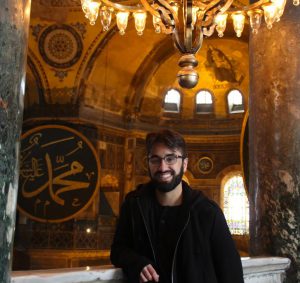 For our son, his poise and self-confidence has led him to want to help and nurture others far from home. His attachment to us has resulted in his attachment to others who are in need and to a world that can benefit from his patience, empathy, and generosity. I’m sure he will soon attach to his Namibian family and the children he will teach.
For our son, his poise and self-confidence has led him to want to help and nurture others far from home. His attachment to us has resulted in his attachment to others who are in need and to a world that can benefit from his patience, empathy, and generosity. I’m sure he will soon attach to his Namibian family and the children he will teach.
If you are reading this after a sleepless night where you were kicked much, or had to get up to comfort your child, be assured: Attachment Parenting will be worth it in the end. Your child may end up in the Peace Corps, too.
Staying centered despite your child’s public meltdown
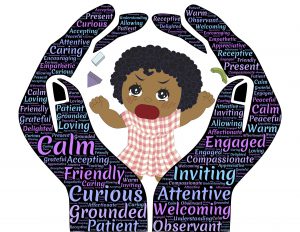 You can tell a lot about a person by their shopping cart — and also how they deal with their toddler’s tantrum in the middle of the store.
You can tell a lot about a person by their shopping cart — and also how they deal with their toddler’s tantrum in the middle of the store.
Clean-up needed in Aisle 9 — 3 year old having a meltdown after being in the store for 2 hours while Mom is looking for gravy packets. Wouldn’t it make sense to put the gravy packets next to the instant potatoes and boxed stuffing?!
The clean-up needed isn’t from the once-nicely stacked boxed pasta now strewn across the floor from the flailing arms and legs of the child. It’s needed to unclog the aisle from passersby, so Mom can fully focus on her child without the distraction of what can seem like annoyed, judging looks of others.
I have seen many a stressed-out parent in the store try to keep their patience with a tired-out, hungry child in the store. Even timing shopping trips between naps and snacks doesn’t always work to prevent public tantrums. How much more patience parents might have if they didn’t feel pressure — real or perceived — from others to do something now with their seemingly out-of-control child!
I have been that parent, who is otherwise able to empathize with my child’s strong emotions but who second-guessed herself after a decade of Attachment Parenting, because of an old lady’s furrowed brow when my kid — with an especially high whine — complained about the length of the grocery trip.
The good new is, though we may sometimes still second-guess ourselves, the longer we practice Attachment Parenting, the easier it is to get back to the values we strive to espouse and pass down to our children, such as that responding with sensitivity and positive discipline is more important than pleasing a disapproving stranger.
It helps me to think that others aren’t necessarily disapproving. We don’t know each other after all. We don’t talk to each other, other than the polite “excuse me” when passing in front of the chips shelf she’s studying. There is no appropriate opportunity to get deep with the person to ask why that person has such a seemingly unhappy disposition at that moment. It very well could be that it has nothing to do with my child — even if the person, if asked, would disagree. Each of our world perspectives is made up of countless factors — current environmental stimuli are actually a small fraction of how we perceive the world at any one time. So much of it depends instead on our values, our background, if we’re hungry or tired or feeling unwell, our relationship health with others, and so on.
I learned this through Nonviolent Communication. Learning the premise of this communications style can be life-changing.
Another life-changing skill is mindfulness — the art of being present in our lives.
Attachment Parenting International (API) is offering you an opportunity to learn more about mindfulness and mindful parenting on Monday, September 12, through an API Live! teleseminar with Jon Kabat-Zinn, PhD, and his wife Myla, mindfulness experts and coauthors of Everyday Blessings: The Inner Work of Mindful Parenting. It’s as easy as listening in on your phone. The live teleseminar starts at 9 pm EST, and all registrants will receive a downloadable recording after the event. Register here.
Research shows that being mindful can reduce stress and have profound effects on physical and mental well-being through a greater sense of balance, empathy, clarity, and peace.
Peace seems over-rated sometimes, with how much the word is used, but it’s actually underestimated in how much striving toward peace can improve your life. Peace implies that you feel content with your life — a nice, constant happiness — rather than riding life’s ups and downs in the search for the peak of happiness…which of course feels good, but it never lasts. But peace lasts.
Peace makes it easier to get through the grocery store with a cranky child, and easier to look past that stranger’s glare to empathize with her unknown situation, and easier to stick to your values of Attachment Parenting.
Growing up in an attached family, learning the power of stimulus
 My home life was rich in attachment — and stimulus.
My home life was rich in attachment — and stimulus.
Attachment begins with the creation of emotionally close, consistent relationships between parents and children in all child development stages. Then, in order that the child can develop his abilities properly, stimulus is essential.
From an early age, I was inserted into the great world of letters. I remember watching my father carefully reading the dictionary while reading the newspaper. He looked at me and read the new word he had just learned in the dictionary. Even without understanding very well the meaning of words, he regaled me with books, and I loved to flick through the pages, which were rich in colors and illustrations.
My mother also had great motivation for reading. She told me that much of the knowledge she has acquired about parenting and motherhood came from magazines. Thus, I grew up admiring the art to practice a good read, and exchange knowledge with people.
Plays of make-believe nourished my imagination and my childhood. My sister and I loved to invent theater pieces to present to a large, imaginary audience. We used to hang a sheet over a clothes line, which we called “the curtain,” in order to open to the “public” and make our act.
Play is essential in a child’s life, because it creates rhythm and meaning through the senses and movement. It is necessary that parents show interest in the play and first discoveries of children, because these practices create meaning and encouragement for the child.
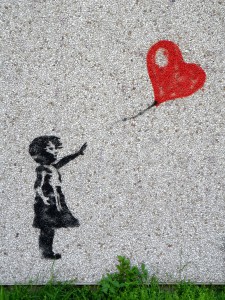 I always had a lot of support from my family in all areas of my life, but the most valuable thing I learned from my parents was about the importance of listening to your child. Not just hear through the words, but mostly watching what was not said, the nonverbal messages. In addition, to be able to identify a feeling even when they are not expressed in words, it is necessary to know the temperament of your child and her “intelligences.”
I always had a lot of support from my family in all areas of my life, but the most valuable thing I learned from my parents was about the importance of listening to your child. Not just hear through the words, but mostly watching what was not said, the nonverbal messages. In addition, to be able to identify a feeling even when they are not expressed in words, it is necessary to know the temperament of your child and her “intelligences.”
Howard Gardner is a psychologist and professor known for developing of the theory of multiple intelligences, which points out that a person has multiple intelligences distributed in various skills, such as logical reasoning, language, music, spatial sense, kinesthetic ability, and interpersonal and intrapersonal skills. Transferring the theory of multiple intelligences into parenting, think about learning moments between parents and children through stimulus.
Stimulus is crucial for development. Without stimulus, the child does not learn, cannot feed, does not gain confidence and autonomy, and is unable to strengthen relationships. My childhood was characterized by an attachment-based parenting approach that valued education by stimulus. It was like that when I learned my first numbers and letters through books presented by my father and board games I used to play with my sister, when I perfected my motor coordination and posture through dance classes encouraged by my mother, when I really understood about equilibrium and confidence in the moment that I learned to ride a bike, and when I received encouragement from my parents while I was studying my on my sat prep. It is very important that children can develop everyday experiences to strengthen skills, and the family must be aware of this.
To educate through positive, attachment-based stimulus is to educate for a happier and fulfilling life, promoting the development of more confident children who able to influence the world positively and creatively.

